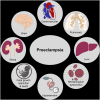Preeclampsia pathophysiology and adverse outcomes during pregnancy and postpartum
- PMID: 37007771
- PMCID: PMC10060641
- DOI: 10.3389/fmed.2023.1144170
Preeclampsia pathophysiology and adverse outcomes during pregnancy and postpartum
Abstract
Background: Preeclampsia is a disease with far-reaching consequences that extend beyond the immediate postpartum period and have a significant impact later in life. Preeclampsia exerts an effect on most organ systems in the body. These sequelae are mediated in part by the incompletely elucidated pathophysiology of preeclampsia and the associated vascular changes.
Content: Current research focuses on unraveling the pathophysiology of preeclampsia with the goal of implementing accurate screening and treatment modalities based on disease development and progression. Preeclampsia causes significant short- and long-term maternal morbidity and mortality, not only in the cardiovascular system but also in other organ systems throughout the body. This impact persists beyond pregnancy and the immediate postpartum period.
Summary: The goal of this review is to discuss the current understanding of the pathophysiology of preeclampsia as it relates to the adverse health consequences in patients impacted by this disease, along with a brief discussion of ways to improve overall outcomes.
Keywords: hypertension; long-term effect; morbidity; preeclampsia; pregnancy.
Copyright © 2023 Bisson, Dautel, Patel, Suresh, Dauer and Rana.
Conflict of interest statement
SR reports serving as a consultant to Roche Diagnostics and Thermo Fisher Scientific and has received funding from Roche Diagnostics and Siemens for studies related to the use of angiogenic factors in pregnancy which is unrelated to work for this manuscript. The remaining authors declare that the research was conducted in the absence of any commercial or financial relationships that could be construed as a potential conflict of interest.
Figures


References
-
- CDS . Pregnancy Mortality Surveillance System. Atlanta, GA: CDS; (2022).
Publication types
LinkOut - more resources
Full Text Sources

